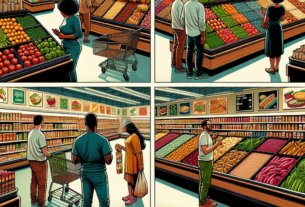Introduction
The foodservice industry is constantly evolving to meet the changing demands and preferences of consumers. In 2025, we can expect to see a number of exciting innovations that will shape the future of the industry. From new technology to sustainable practices, the top 10 innovations in foodservice to watch in 2025 are poised to revolutionize the way we eat and drink.
1. Robotics and Automation
One of the most significant trends in foodservice is the increasing use of robotics and automation. From self-driving delivery vehicles to robotic kitchen assistants, automation is revolutionizing the way restaurants operate. For example, some restaurants are using robotic chefs to prepare meals, leading to increased efficiency and consistency in food preparation.
Market Share
According to a report by Allied Market Research, the global food robotics market is expected to reach $3.1 billion by 2025, with a compound annual growth rate of 12.7%.
Future Plans
Many restaurants are looking to expand their use of robotics and automation in the coming years. For example, some chains are exploring the use of robotic servers to enhance the dining experience for customers.
2. Plant-Based Alternatives
The rise of plant-based alternatives is another key trend in the foodservice industry. With increasing concerns about sustainability and animal welfare, many consumers are turning to plant-based options for their meals. For example, Beyond Meat and Impossible Foods have gained popularity for their plant-based burger patties that closely mimic the taste and texture of beef.
Financials
According to a report by Market Research Future, the plant-based food market is projected to reach $74.2 billion by 2025, with a compound annual growth rate of 9.6%.
Future Plans
Many restaurants are expanding their plant-based offerings to cater to the growing demand for these products. For example, some fast-food chains are introducing plant-based burger options to their menus.
3. Ghost Kitchens
Ghost kitchens, also known as virtual kitchens or cloud kitchens, are another innovation that is gaining traction in the foodservice industry. These kitchens operate without a physical storefront, allowing restaurants to fulfill delivery and takeout orders more efficiently. For example, Kitchen United operates a network of ghost kitchens that cater to multiple restaurant brands from a centralized location.
Market Share
According to a report by Euromonitor International, the global ghost kitchen market is expected to reach $1 trillion by 2025, with a compound annual growth rate of 25%.
Future Plans
Many restaurants are exploring the use of ghost kitchens to expand their delivery and takeout capabilities. For example, some chains are partnering with ghost kitchen operators to reach new customers in different locations.
4. Augmented Reality Menus
Augmented reality menus are a cutting-edge technology that is transforming the way customers interact with restaurant menus. By using a smartphone or tablet, diners can view 3D images of menu items, see nutritional information, and even watch cooking demonstrations. For example, KabaQ offers an augmented reality menu platform that allows customers to visualize menu items before ordering.
Financials
According to a report by Grand View Research, the global augmented reality market in the foodservice industry is expected to reach $1.5 billion by 2025, with a compound annual growth rate of 48%.
Future Plans
Many restaurants are looking to implement augmented reality menus to enhance the dining experience for their customers. For example, some upscale restaurants are using augmented reality to showcase the ingredients and preparation techniques used in their dishes.
5. Contactless Payment
Contactless payment is becoming increasingly popular in the foodservice industry, allowing customers to pay for their meals without physical contact. With the rise of mobile payment apps and NFC technology, contactless payment is revolutionizing the way transactions are conducted in restaurants. For example, Apple Pay and Google Pay allow customers to pay for their meals with a simple tap of their smartphone.
Market Share
According to a report by Statista, the global contactless payment market is expected to reach $6.7 trillion by 2025, with a compound annual growth rate of 17%.
Future Plans
Many restaurants are adopting contactless payment systems to streamline the ordering and payment process for customers. For example, some fast-food chains are implementing self-service kiosks that accept contactless payment methods.
6. Food Waste Reduction
Food waste reduction is a growing concern in the foodservice industry, with many restaurants looking for ways to minimize waste and improve sustainability. From composting food scraps to donating excess food to local charities, restaurants are taking proactive steps to reduce their environmental impact. For example, some restaurants are using technology to track and analyze their food waste, allowing them to make data-driven decisions to reduce waste.
Financials
According to a report by ReFED, the food waste reduction market is projected to reach $47 billion by 2025, with a compound annual growth rate of 5%.
Future Plans
Many restaurants are implementing food waste reduction initiatives as part of their sustainability efforts. For example, some chains are partnering with food rescue organizations to donate excess food to those in need.
7. Personalized Nutrition
Personalized nutrition is a trend that is gaining momentum in the foodservice industry, with many restaurants offering customized meal options based on individual dietary preferences and requirements. From gluten-free to vegan, customers can now tailor their meals to suit their specific needs. For example, Sweetgreen allows customers to customize their salads with a variety of ingredients and toppings.
Market Share
According to a report by Zion Market Research, the global personalized nutrition market is expected to reach $16.4 billion by 2025, with a compound annual growth rate of 9.5%.
Future Plans
Many restaurants are incorporating personalized nutrition into their menu offerings to cater to the diverse dietary preferences of their customers. For example, some fast-casual chains are using digital platforms to allow customers to build their own meals based on their dietary restrictions.
8. Delivery Drones
Delivery drones are a futuristic technology that is revolutionizing the way food is delivered to customers. By using unmanned aerial vehicles, restaurants can deliver meals to customers’ doorsteps quickly and efficiently. For example, Amazon Prime Air is testing drone delivery for food and grocery items in select markets.
Financials
According to a report by Research and Markets, the global delivery drone market is projected to reach $4.1 billion by 2025, with a compound annual growth rate of 23%.
Future Plans
Many restaurants are exploring the use of delivery drones to enhance their delivery services and reach customers in remote locations. For example, some pizza chains are testing drone delivery for hot and fresh pizzas.
9. Smart Kitchen Appliances
Smart kitchen appliances are another innovation that is reshaping the foodservice industry. From connected ovens to intelligent refrigerators, these appliances are equipped with sensors and AI technology to streamline food preparation and cooking. For example, Samsung’s Family Hub refrigerator allows users to access recipes, order groceries, and control the temperature of their fridge from a mobile app.
Market Share
According to a report by MarketsandMarkets, the global smart kitchen appliances market is expected to reach $32.1 billion by 2025, with a compound annual growth rate of 18%.
Future Plans
Many restaurants are investing in smart kitchen appliances to improve efficiency and reduce operational costs. For example, some fine dining establishments are using smart ovens and cooktops to ensure precise cooking temperatures and timings.
10. Virtual Reality Dining Experiences
Virtual reality dining experiences are a novel concept that is gaining popularity in the foodservice industry. By using VR headsets, diners can immerse themselves in virtual environments while enjoying their meals. For example, The Waldorf Astoria in Dubai offers a VR dining experience where guests can dine in exotic locations like the Maldives or Paris.
Financials
According to a report by MarketsandMarkets, the global virtual reality market in the foodservice industry is projected to reach $3.1 billion by 2025, with a compound annual growth rate of 32%.
Future Plans
Many restaurants are exploring the use of virtual reality dining experiences to create unique and memorable dining experiences for their customers. For example, some themed restaurants are incorporating VR technology to transport diners to different worlds while they enjoy their meals.
In conclusion, the foodservice industry is undergoing a period of rapid innovation and transformation, driven by advancements in technology, changing consumer preferences, and a growing focus on sustainability. The top 10 innovations in foodservice to watch in 2025 are poised to revolutionize the way we eat and drink, offering exciting new possibilities for both restaurants and customers alike.


